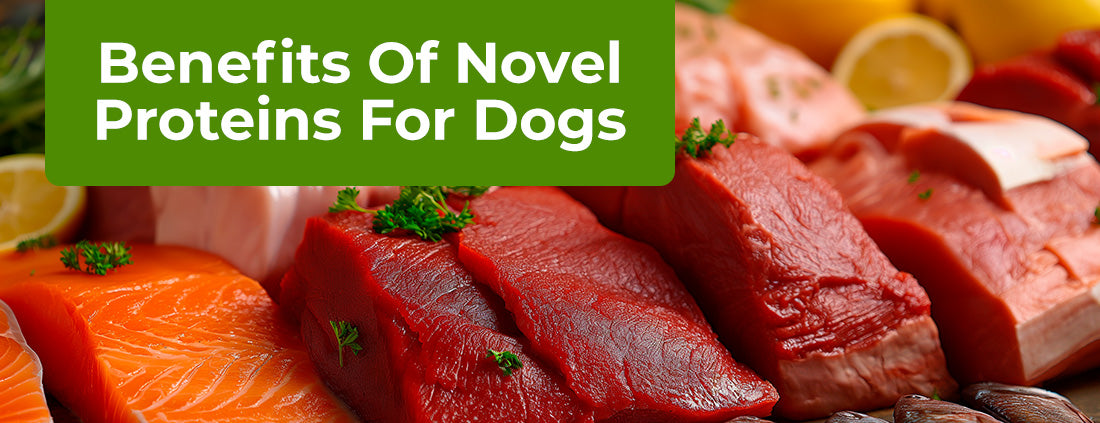- Pros and Cons Of Traditional Proteins
- Pros and Cons Of Novel Proteins
- Which Protein Source Is Best For My Dog?
- Creating High-Protein Meals With ChefPaw
- Using ChefPaw To Conduct The Elimination Diet
Many pet parents are surprised to hear that beef, dairy, and chicken account for 66% of total food allergies seen in dogs, with beef accounting for 34% alone. The reason our dogs often have allergic reactions to these proteins is because of how common they are in commercial dog foods. Overexposure to meals created with limited ingredients is a great way to give our dogs an allergy that can affect them for the rest of their lives.
Unfortunately, most pet parents are never told this and only find out about it when it’s too late, i.e., their dog has a food allergy. This is why we are seeing a surge in meals created with novel proteins. Novel proteins are protein sources uncommon in mainstream commercial foods. Novel proteins include bison, turkey, pork, rabbit, and fish. There are even insect-based dog foods! Yes, really!
The benefits of novel proteins don’t stop at their ability to help us tackle food allergies, however. Join us as we explore the many benefits of novel proteins and whether they are right for your dog.
Pros and Cons Of Traditional Proteins
There is nothing inherently wrong with feeding our dogs traditional sources of protein like beef. The problem is when we solely rely on giving our dogs just one or two, overexposing them to meals that lack diversity.
Pros
- They Are Familiar: If you’re a meat eater, you’re probably familiar with traditional proteins like beef and chicken. When looking to create your dog’s food for them at home, these protein sources are great places to start with. And they are very easy to find in grocery stores.
- Affordable: Due to how common traditional proteins are, they are traditionally cheaper than their novel counterparts. Then, it’s very easy to find grocery store deals on traditional proteins like chicken.
Cons
- Common Allergens: The more often a dog eats the same protein in their meal, the more likely they will develop an allergy to it. Despite wheat being a common ingredient in dog foods, it only accounts for 13% of cases.
- Antibiotic Concerns: Traditional proteins come from large industrial factory farms that are prone to over-reliance on antibiotics and other treatment measures due to overcrowding that promotes these settings to see more diseases.
Pros and Cons Of Novel Proteins
Pros
- Reduced Allergy Risk: The biggest benefit of novel proteins is their ability to allow your dog to continue to have affordable homemade high-protein meals, without having to switch to expensive allergy-control dog foods.
- Sustainable: Several novel protein sources are more environmentally friendly and sustainable than traditional protein sources from animals that are raised in industrial farms.
- Omega-3 Fatty Acids: Novel protein sources such as salmon can offer our dogs all the essential omega-3 fatty acids they need. Reliance on traditional land-derived protein sources will result in the need for omega-3 supplementation.
- Lower Calories And Less Fat: A 4-ounce serving of bison ribeye has 177 calories, 6 grams of fat, and 30 grams of protein, whereas your typical 4-ounce beef ribeye contains 265 calories, 17 grams of fat, and 27 grams of protein.
- It’s Exciting: New smells and new flavors, what’s a dog not to love?
Cons
- Cost: Due to their rarity, novel proteins can have a higher price point than traditional proteins. However, this rarity also creates less of a demand for them, so with some shopping around, it is possible to find novel proteins at the same prices or cheaper than traditional sources.
- Harder To Find: Chicken is very easy to find in the grocery store, rabbit on the other hand not so much. However, pork and turkey are considered novel proteins, and they are pretty much as easy to find as chicken and beef. As well, bison is quickly finding itself a staple in big-box grocery stores. Other novel protein sources can be easily found online to order.
Which Protein Source Is Best For My Dog?
In many cases, a combination of traditional and novel proteins will work best. Not only does it diversify your dog’s meals, which will greatly help discourage allergies, but it also allows you to shop around, saving you even more money by making your dog’s food at home.
Now, if you suspect your dog is experiencing food allergies, a switch to meals created with novel proteins is a great way to kick off the elimination diet. The elimination diet is the most accurate way to diagnose food allergies in dogs.
Due to food intolerance, which shouldn’t be mistaken for a food allergy, unless otherwise recommended by your vet, gradually introduce novel proteins into your dog’s regular diet. You only want to introduce one source at a time to confirm it doesn’t cause any issues before introducing another.
Creating High-Protein Meals With ChefPaw
Thanks to ChefPaw, the handy countertop assistant who does all the prep work and cooking for you, creating high-quality affordable meals rich in protein at home has never been easier. With a built-in library of over [#] recipes, ChefPaw gives you a range of recipes that utilize a large range of protein sources — both traditional and novel.
With the ability to customize any of the recipes, you can easily combine traditional and novel protein sources or switch them out without having to change the entire recipe. ChefPaw’s nutrient analyzer will make any small changes to the recipes as needed when switching one ingredient for another, ensuring your dog’s meals stay complete and balanced.
Using ChefPaw To Conduct The Elimination Diet
There are several reasons we love making homemade dog food, but its ability to best carry out the elimination diet is at the top. And that’s because you control and know all the ingredients that are going into your dog’s meals.
Why You Should Create Your Own Elimination Diet Meals
— Despite numerous recalls and safety warnings, commercial foods, even specialty-based diets, are often found to contain hidden ingredients. Research has even noted the difficulties in performing food trials due to how common mislabeling is. —
Sometimes hidden ingredients happen because the manufacturer is dishonest. Some brands will simply list “natural flavor” on the label instead of saying what protein source they used. Could be chicken, could be beef. But this is so concerning since these two proteins alone account for around half of all food allergies.
Other times, unlabeled ingredients occur because the food was prepared in a facility where other food items are created, resulting in cross-contamination. So even when you know the tricks to look for on a food label, you can’t be certain it’s accurate and safe.
To add insult to injury, specialty-based diets, like ones formulated for the elimination diet, are needlessly expensive just because commercial brands know pet parents don’t have a great alternative. Well, that was until ChefPaw, that is!
Oh, and we can’t forget to mention that most commercial allergy-based foods feature either highly processed and synthetic protein or a hydrolyzed protein source that’s plant-derived. Here’s why ChefPaw is better.
Why You Should Use ChefPaw For Elimination Diet Meals
— Tracking over 60 individual (essential) nutrients, ChefPaw and its nutrient analyzer give you and your veterinarian unparalleled insight and control over your dog’s elimination diet. —
Strict Elimination Diet W/ ChefPaw
Taking place over 6 to 12 weeks, the traditional elimination diet is very simple, only including a single protein and carbohydrate. This means your dog will not be getting complete and balanced meals during this time.
Starting the elimination diet without ChefPaw isn’t too much work, however, ChefPaw will still save you on prep and cooking time. Regardless, we believe it's a good idea to use ChefPaw from the start. Here’s why!
ChefPaw’s nutrient analyzer, which tracks 68 nutrients, can pinpoint which nutrients are falling on the wayside and by how much. I.e., your vet is going to love the ability to see exactly what your dog is and isn’t getting. This gives them crucial information for determining how long your dog should be on an elimination diet. As well as which foods are best to slowly introduce when transitioning back to complete and balanced meals.
Meals will need to return to featuring a range of wholesome ingredients, which ChefPaw definitely makes it easier to handle. These meals can be quite difficult to solely create by oneself and often feature an unbalanced nutrient profile, meaning it may be better to return to commercial foods. But that’s no fun for your dog’s taste buds or your wallet after enjoying the benefits of homemade meals. This is why we love using ChefPaw right from the start.
Whole-Foods Elimination Diet W/ ChefPaw
“It’s not the ingredient that’s the issue, it’s how it’s processed!”
This is what more and more veterinarians are finding to be the true culprit in the rise of pet food allergies. In many cases, before implementing a strict elimination diet, meals created with whole foods and free of highly processed ingredients can be trialed first.
Recipes such as #2c Allergy Care with Turkey and Sweet Potato and Novel Bison Protein & Rice provide complete and balanced nutrition while eliminating the most common allergens seen in research. ChefPaw’s app makes it simple to whip these meals together. And they will be formulated to your dog's weight, age, and on, creating even more balanced meals.
Thanks to the success of whole-food single-meat protein diets, veterinarians and pet parents are finding them to be a preferable tool to gauge whether the traditional elimination diet is needed or not. A dog that’s been struggling with food allergies, especially, if it’s been for a while, may already be experiencing nutritional issues. The whole-food diet can prevent us from aggravating that further, by avoiding incomplete and unbalanced meals.
It’s important you work closely with your vet regardless of the style of the elimination diet you wish to carry out. Sometimes these trials need to be run multiple times. As well, another core component of them is temporarily reintroducing the suspected allergen to confirm it’s the culprit.

